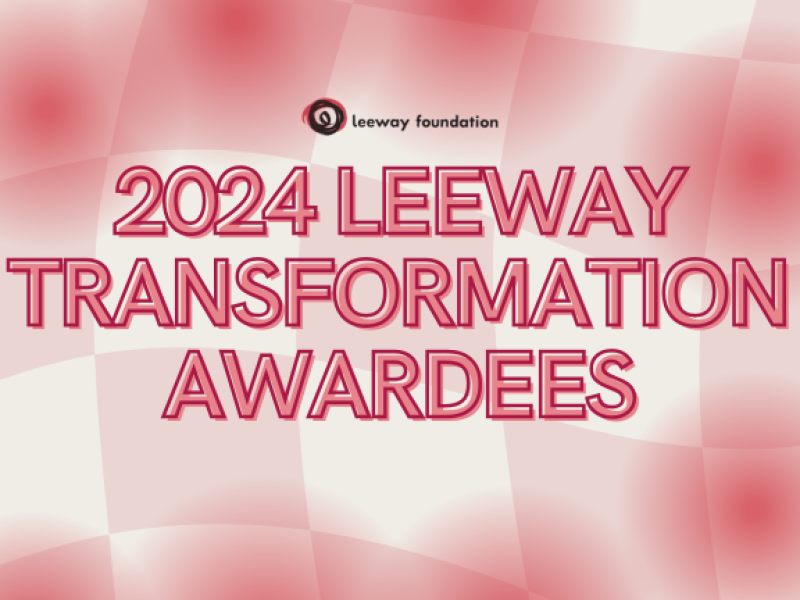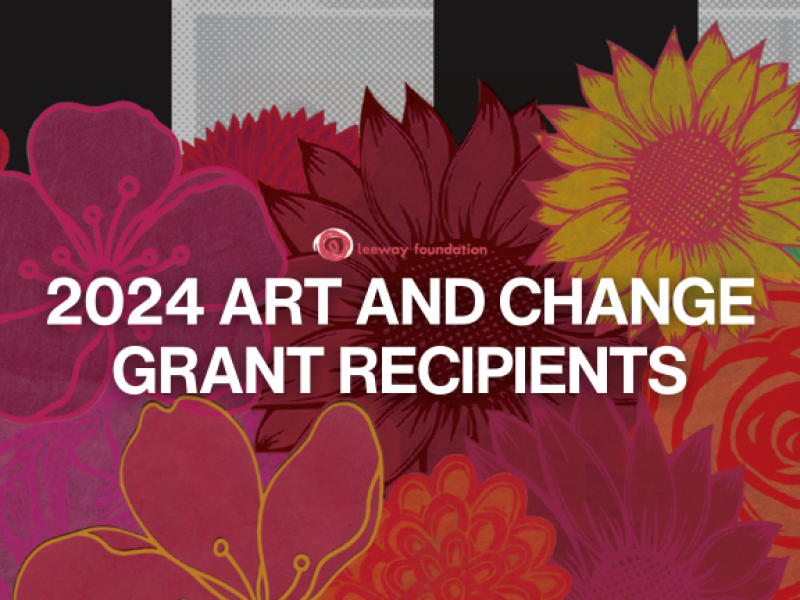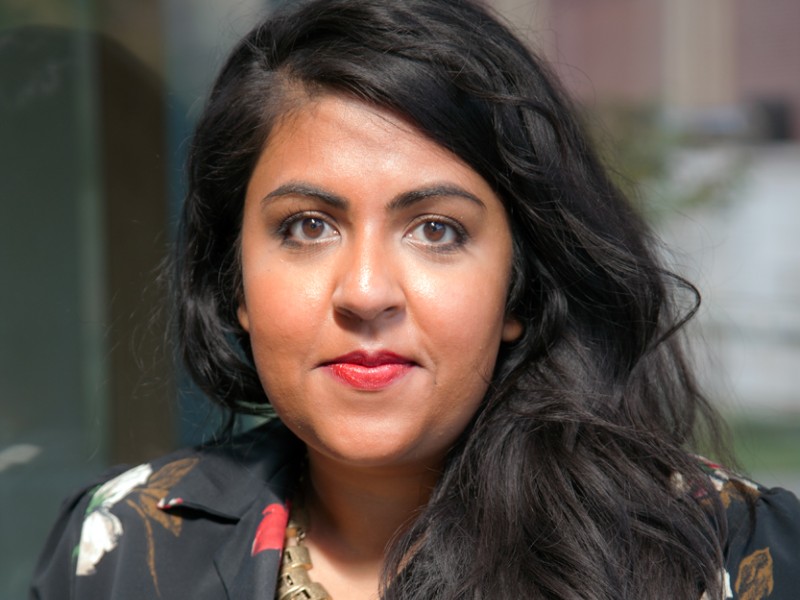Leeway @ 25: Interview with One Is Part Of The Many

Who are you?
Anula Shetty: I am a filmmaker. I used to define myself by my profession, but now I’ve expanded to identifying myself as an artist, a mother, an activist…I guess that’s my answer.
Michelle Angela Ortiz: Well, I usually say a visual artist and community arts educator, but if I were to really think about things I produce or make, I do large scale public art installations surrounded around, or resulting in a mural or temporary install centered around community stories and like, how I feel connected to those community stories. You know, like Anula -- a mother, a child of immigrants, a person who lives in the city, but...I just remember my mom always saying, “In Colombia we do this, and in America they do this,” you know, with this “they” – a sort of distance, not realizing that we are also sort of Americans in this way; so kind of growing up in that duality, and I think that that’s also the stuff that I am interested in, in terms of stories…I love having conversations with individuals who are like, “I don’t really have a story to tell”, and then three hours later, you have this beautiful book.
Betty Leacraft: My name is Betty Leacraft, fiber/mixed media artist, fiber textiles. I go by the pronoun she/her; I got used to that by way of learning Leeway’s way of doing things. I have not been a mother, but I feel that way every time I have a class of students, so I say I’m their mom for the period of time that I have had them, and that goes for kids or adults. I consider myself an indigenous West Philadelphian, it’s only recently that I’ve been living in North Philadelphia, the last two years. And I guess I would say my work revolves a lot around culture, the appreciation of it, the awareness of it, and the capability of interacting with diverse groups because I love interacting with different cultures, and you know, you gotta eat their food, and know their textile traditions, in particular…I like to address issues of identity, heritage, cultural symbolism, nature, community, and cultural preservation.
What is your role in or relationship to the Leeway Community?
Michelle: Well, I can say that the very first grant that I received as an independent professional artist outside of school was a Leeway grant, and so that was a huge deal. I was still a studio artist doing work in my studio, but there was a huge component of my work in communities and public art and being in my community and also having that social justice component, so when Leeway came into the picture, I was like, “Oh my gosh, this is for me! This is what I do.” To see that there was funding and a process that was really thoughtful, not just around our product but also the way we really do our work, was so refreshing and it was so great to really have that support. I say Leeway was my good luck charm because I really had my first grants, I was able to get better in my grant writing in how I speak about my work, be connected to other artists doing work in the same field and to have a sense of family and community...you know, I'm not really doing this by myself or facing this obstacles on my own. This is what Leeway means to me.
Anula: I feel very similar. It wasn’t my first grant, but I used to give grants as an artist and serve on grant panels and in those conversations, there would always be one person who would say “But is this really art?” and I always found it ridiculous that that was even something to talk about. It was so great with Leeway, like what Michelle was just talking about with all these grants... you really feel drawn to it and working with it, suddenly you had a voice and it felt like you were being respected and acknowledged. It was so amazing to be in the art world, and to have this work with communities with social change be honored in that way, so yeah, I just remember how freeing it was to write a grant and talk about my passions working with community without having to explain why it is art and just have it taken as a given that this is valuable.
Betty: I began to think of Leeway as extended family, because the first grant that I got through Leeway was the WOO in [1999], I was scared to death because I didn’t know if I would be eligible, but I was part of this amazing traveling group and it was going all these wonderful places and it was a floor installation to compliment what was going on the wall...I wrote the grant based on the fact that I had to put the installation up and I got it and it was great. So from that point, I didn’t apply again until around 2006… And what I got is that they don’t want to hear the jargon, they don’t need the magic words, they really care about the feeling and the heart, and I felt a great comfort in that. I didn’t realize what I was doing was called art and change work; it didn’t have a name, so once art and social change became a phrase quote unquote on everyone lips, I was like, “Oh, this is what it’s called that I do!” And now, all the people who were saying all that stuff way back then are trying to do art and change work, and I’m like… yeah, but you’re only doing this because you think it’s the next big thing; this has been what I have been doing without knowing that that is eventually what it would be called. So, the fact that this organization really fosters this kind of, art expression, project, formulation and that kind of commitment to that kind of practice, it meant that I didn’t have to care about what anybody else thought.
What have you seen change at Leeway in the time you have been involved in the community? What does that mean in terms of doing this 25th anniversary exhibit for an organization that has gone through so many changes? Have you all worked together before?
Unison: No!
A: We’ve always admired each other’s work, but this is the first time we’ve gotten to collaborate.
So was it Denise [Brown] that asked you to work together?
A: No! I think it was Michelle!
Oh, that’s right! She asked you who you wanted to work with.
M: So it came out of this conversation with Denise -- and this is what I love with the foundation -- we had this idea of honoring grantees with names, and then I had this vision of people moving through a space that is like fabric, like flowing fabric that could have like names and then I thought of sounds later on…and Denise said, “Would you like to collaborate with someone?” I said to myself, “Who would I like to collaborate with!?” So I thought of Betty and Anula, because I had already been thinking about like fabric and sound and projection, and I thought about who is already good at doing that, and oh they’re already grantees and I really admire their work, and them as people…I didn’t even have any second choices, I was just like, “I hope Betty and Anula say yes.”
A: Yeah, it was amazing! Just right from our first meeting, it was incredible how the ideas started flowing like, how can people flow, move through this space…we started talking about rituals and my father had recently passed away when we first started meeting, so I was very much thinking about the Hindu death ritual, and the symbolism of every direction of movement and how important that is and then we also were talking about other kinds of rituals and ideas and I just really felt like we were all really on the same [page]… it was a really fascinating, exciting process.
B: The thing I find really interesting is that we are all very grounded in our cultural identities and ways of doing things and you know, I don’t know everything that’s going on in their cultures, but I know enough where we have parallels, where we are comfortable right away in terms of talking. When we sat down and thought about this honoring of ancestors at Leeway, there are elements of all of our cultures that we could bounce off one another for ideas or ever just for additional knowledge, and I appreciate the fact that they’re so accomplished with what they do and I’m thinking if I’m included in this group, I’m pretty good!
So with Leeway and the last 25 years of the organization, what themes about Leeway are you trying to pull out?
M: Well, I think the title of the installation is from the [Leeway] vision poem, which really stood out when we were reading it. We were trying to figure out where are we trying to base our thought process…that’s where I really appreciated these conversations with Anula and Betty because there’s never been a “wait don’t do this don’t do that”; it’s always constantly flowing and so the “One is Part of the Many”. I think it really relates to what we each individually contribute to family, to community, that’s what we bring to the table.
A: Yeah, that line really stood out to us. I think what’s really nice about “One is Part of the Many” is that it resonates in so many ways, in both our art and our communities, and it’s tied so closely to what Leeway and what Leeway artists are doing… it is this idea that we’re not going for this huge blockbuster production; it’s about transforming the lives of one person, even if you reach one that’s enough, creating change in that way.
M: I think it also echoes what we talked about in terms of ancestors and what we carry with us and what I think is that with every step, they are walking with me. So even in terms of our exhibit, we’ll be honoring grantees that have passed on, acknowledging their contributions, and acknowledging even how important that is… like, if Leeway didn’t exist where else would we be recognized? And how do we continue to honor and elevate ourselves and our communities and the people who continue to make that change?
So, the next question is what you see about the future of Leeway.
B: I’m not sure I can answer that because if I could I could be in another line of work! But I think what they're going to do is continue to evolve in whatever the various ways they continue to be. An organization like this, I think, isn’t going to go backwards. It’s only going to go forwards. And because Leeway has embraced so many different types of people -- culturally, in gender diversity, including not being accused of ageism, as so many places do. So I just think they’ll find other ways to further develop their mission and probably some new things will come, I just don’t know what they’ll be because looking back over their years, there are things now that have been put in place that weren't there may be ten years ago. So, I just see a constant evolution in whatever way that will manifest.
M: And another thing I hope to see expand and grow is to continue the conversations around Art and Social Change work in spaces where we’re not always represented and I mean I know they’ve done the collaboration with Moore, but what does this mean for the next generation of women, and I’m not talking about generation in terms of age, I really mean wherever you when you enter doing this kind of work… I guess in the sense mentorship, how are we still connected to one another?
If Leeway were a playlist, what song would you be?
B: This is an old one from a group called Sly and the Family Stone and they have this song You Can Make It If You Try… we used to jam to that one cause Sly Stone had this rhythm thing going on where the only reason you couldn’t dance is because you didn’t have feet and even that might not stop you from moving around in your chair!
A: So for the playlist, all I can think about is a Hindi song Aap Jaisa Koi…it’s a song which I heard when I was growing up in the 70s, with this singer from Pakistan…no not Pakistan, London! Her name was Nazia, and I just remembered all the girls wanted to be her, [because] she was so confident, and the meaning of the song is, “If someone like you were to come into my life, that would make it”, that’s basically the translation... and I feel that way with Leeway, just having Leeway as part of my life is transformative.
M: The first one that came to my mind -- which is hilarious-- is I Will Survive, but the Celia Cruz version, and I just love the way Celia sang it…you know, you hear I Will Survive and you’re like, “okay, I’ve heard this so many times”, but when you hear Celia sing it the way that she did -- she sang it at one of her very last concerts -- and you hear this strength, this feminine energy, and it was one of the first things that popped in my mind.





